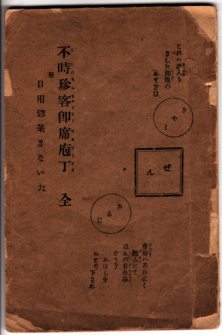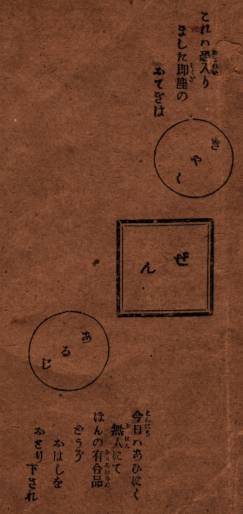Knifing your guests, in a good way
Behold the cover of 『不時珍客即席庖丁、全(附:日用惣菜まないた)』 ("The Impromptu Kitchen Knife for Unexpected Guests, Complete (Including Everyday Dish Chopping Board")!

It may not look exciting, but re-read that title. It's not a "recipe book" or a "guide". It is a "knife". You're not hardcore unless you entertain hardcore.
Another intriguing thing about this book: it seems to have been imported from Flatland. Consider the scene depicted on the cover:

Mr Kyaku ("guest") and Mr Aruji ("head of the household") are both circles, seated across the square zen, or table, from each other (with respectful angling on Mr Aruji's part).
"Dear me," says Mr Kyaku (top), using pre-war orthography for his topic-marker particle. "Terribly sorry to impose so suddenly."
Mr Aruji (for it is he!) replies with an apology of his own: "Unfortunately the help is off today, so here are a few things that we had lying around. Please, take a pair of chopsticks."
And where is (the presumably needle-shaped) Mrs Aruji? She's inside the book, reading fabulous lists of things she might want to prepare for the men. For example, this being February, she might rustle up some salted bamboo shoot or pickled abalone and bracken; maybe some chopped lobster, udo shoots, jellyfish, smartweed and/or ginger. Some piping hot vegetable and baby clam soup wouldn't go astray either. But don't go to any trouble.
There aren't many actual recipes, but here's a fairly representative example of one:
早煎酒の法
古酒四杯醤油一杯酢半杯右の三色を合せ炭火にて三ふきほどにえたてそのまヽおろしはしにてかきまわし人はだにさめたるとき又火にかけてにやし右のごとく三返すればよきいりざけになるなり
HOWTO: fast irizake
Aged sake four cups soy sauce one cup vinegar half a cup mix the preceding three colors [ingredients] together and over a charcoal fire bring this mixture to a boil three times then remove it from the flame and stir it with chopsticks and once it has cooled to the warmth of your skin put it on the fire again and bring it to a boil another three times as described earlier and it will be good irizake.
Sure, it seems obvious to us today that recipes are easier to understand when broken up with line breaks and punctuation, but times were different then. Seriously: this book does not contain any commas. I don't think it's so old that it predates Japan's adoption of the comma, but it might be so old that whoever printed it didn't hold with those newfangled foreign punctuatory marks and such. Also, having the recipe shouted at her in one long run-on sentence, as if by an impatient mother-in-law, probably helped Mrs Aruji retain that sense of urgency she would need to keep her two-dimensional unexpected guests happy.
![[No-sword]](http://no-sword.jp/images/site/no-sword_banner.jpg)



gme:
It boggles the mind a bit that a supposedly fast method for making something could involve boiling it a total of six times (plus cooling). Presumably the proper method involves days and nights of obsessive boiling and fiddling. And all for a dipping sauce.
Edo period limitations on retail outlets notwithstanding, my inclination would have been to summon one of the house servitors (small children, animals) and bid them go hence and buy some of the damn stuff. Sounds quicker.